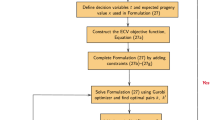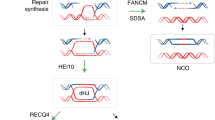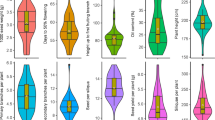Abstract
The phenotypic and genotypic properties of second cycle hybrids are predicted from the means and variances of the F2 generation of two crosses between pairs of inbred varieties of Nicotiana rustica (V1 × V5 and V2 × V12). The predicted properties are compared with the observed properties of the second cycle hybrids generated by crossing the first cycle recombinant inbred lines with the F1 of the original cross (the L3 generation of an inbred line triple test cross) which, in the absence of a linkage disequilibrium, are identical with the second cycle hybrids produced as a diallel set of crosses among the first cycle inbred lines. In the presence of a linkage disequilibrium the diallel set of crosses has a smaller linkage bias than the inbred line × F1 crosses.
The agreement between the predicted and observed phenotypic properties of the second cycle hybrids is good over a wide range of characters in both crosses. The overall correlations between the observed and expected proportions are 0·81 and 0·88 for the V1 × V5 and V2 × V12 crosses, respectively. Furthermore, the genotypic predictions show that only few of the second cycle hybrids and second cycle inbred lines will be superior to the best first cycle inbred lines which were themselves superior to their own better parents and their heterotic F1's.
Genetical explanations of the origins of the superior derivatives of an initial cross are explored using a development of the standard notation of Mather and Jinks (1982).
Similar content being viewed by others
Article PDF
References
Ingram, N R, and Jinks, J L. 1982. Analysis of induced quantitative variation. II. The recombinant inbred lines. Heredity, 48, 79–83.
Jinks, J L. 1981. The genetical framework of plant breeding. Phil Trans Roy Soc Lond, B 292, 407–419.
Jinks, J L. 1983. Biometrical Genetics of Heterosis. In Heterosis. Monographs on theoretical and applied genetics 6. R. Frankel (ed.). Springer-Verlag, Berlin, 1–46.
Jinks, J L, and Perkins, J M. 1969. The detection of linked epistatic genes for a metrical trait. Heredity, 24, 465–475.
Jinks, J L, and Perkins, J M. 1972. Predicting the range of inbred lines. Heredity, 28, 399–403.
Jinks, J L, and Pooni, H S. 1976. Predicting the properties of recombinant inbred lines derived by single seed descent. Heredity, 36, 253–266.
Jinks, J L, and Pooni, H S. 1981. Properties of pure-breeding lines produced by dihaploidy, single seed descent and pedigree breeding. Heredity, 46, 391–395.
Jinks, J L, and Pooni, H S. 1982. Predicting the properties of pure breeding lines extractable from a cross in the presence of linkage. Heredity, 49, 265–270.
Jinks, J L, and Pooni, H S. 1984. Comparison of inbred lines produced by single seed descent and pedigree inbreeding. Heredity, in press.
Mather, K, and Jinks, J L. 1982. Biometrical Genetics, 3rd Edn. Chapman and Hall, London.
Perkins, J M, and Jinks, J L. 1970. Detection and estimation of genotype-environmental, linkage and epistatic components of variation for a metrical trait. Heredity, 25, 157–177.
Pooni, H S, and Jinks, J L. 1976. The efficiency and optimal size of triple test cross designs for detecting epistatic variation. Heredity, 36, 215–227.
Pooni, H S, and Jinks, J L. 1978. Predicting the properties of recombinant inbred lines derived by single seed descent for two or more characters simultaneously. Heredity, 40, 349–361.
Pooni, H S, and Jinks, J L. 1979. Sources and biases of the predictors of the properties of recombinant inbreds produced by single seed descent. Heredity, 42, 41–48.
Pooni, H S, and Jinks, J L. 1982. Comparative analysis of association and dispersion crosses to detect linkage and epistatic components of variation. Heredity, 49, 211–220.
Pooni, H S, Jinks, J L, and Jayesekara, N E M. 1978. An investigation of gene action and genotype x environment interactions in two crosses of Nicotiana rustica by triple test cross and inbred line analysis. Heredity, 41, 83–92.
Robson, D S, Powers, L, and Urquhart, N S. 1967. The proportion of genetic deviates in the tails of a normal population. Der Zùchter, 37, 205–216.
Toledo, J F F De, Pooni, H S, and Jinks, J L. 1984. Predicting the properties of second cycle hybrids produced by intercrossing random samples of recombinant inbred lines. Heredity, 53, 283–292.
Van Der Veen, J H. 1959. Tests of non-allelic interaction and linkage for quantitative characters in g'enerations derived from two diploid pure lines. Genetica, XXX, 201–232.
Author information
Authors and Affiliations
Rights and permissions
About this article
Cite this article
Pooni, H., Jinks, J. & de Toledo, J. Predicting and observing the properties of second cycle hybrids using basic generations and inbred line × F1 crosses. Heredity 54, 121–129 (1985). https://doi.org/10.1038/hdy.1985.16
Received:
Issue date:
DOI: https://doi.org/10.1038/hdy.1985.16



